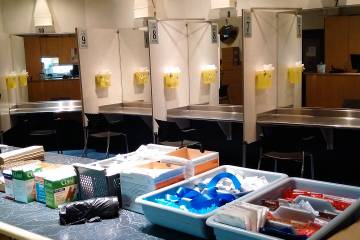Overdose prevention sites are facilities where people can use previously purchased drugs such as opioids under trained supervision. Providing sterile needles, health care services, and referrals to drug treatment, these sites aim to reduce the harms associated with drug use.
"The concept [of overdose prevention sites] confronts the reality that people are using drugs," says Ju Park, an assistant scientist in the Bloomberg School of Public Health. "And we're saying that, in these places, there would be medical professionals and trained staff observing them. Ultimately, that does a lot of public health good."
The first such facility opened in Switzerland in 1986; now at least 100 overdose prevention sites are operating in more than a dozen countries.
Here are a few things we've learned about this harm-reduction strategy:
They save lives
There have been no reported overdose deaths, ever, at an overdose prevention site. A 2011 study published in The Lancet found that fatal overdoses dropped 30% in a Vancouver, Canada, neighborhood served by such a facility.
They save money
A Baltimore-focused 2017 study led by Susan Sherman, a professor in the Bloomberg School, estimated that a $1.8 million annual investment in an overdose prevention site would save the health care system $7.8 million each year through reductions in infections such as HIV and hepatitis C, ambulance calls, emergency department visits, and hospitalizations.
They will be used
A study led by Bloomberg School researchers published this June in the Journal of Urban Health found that some 77% of 326 people, surveyed in three east coast cities, who use drugs expressed willingness to use such facilities.
They help people enter treatment
A Vancouver, Canada, health care provider found that in a single year, more than 400 people who used the city's overdose prevention site also enrolled in an adjoining inpatient treatment program.
They don't exist in the U.S.
Several U.S. states and two cities are pursuing efforts to open such facilities, but the strategy remains controversial, and the U.S. Department of Justice has warned that overdose prevention sites would violate the so-called crack house statute, which makes it a felony to "maintain any place" for using controlled substances. Even so, "many states remain determined to provide this lifesaving intervention," Park says.
This article originally appeared in the Fall 2019 issue of Hopkins Bloomberg Public Health Magazine.
Posted in Health
Tagged opioids, drug policy, safe consumption sites










